Biography
His Last Journey
On January 26, 1959, Bruno Gröning passed away in Paris
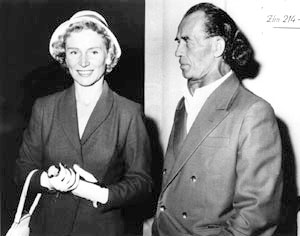
Diagnosis: advanced stomach cancer
In late autumn, 1958, Bruno Gröning drove to Paris with his second wife Josette, whom he had married in May, 1955. Gröning allowed himself to be examined by Dr. Pierre Grobon, a friend and cancer specialist. The X-rays revealed advanced stomach cancer. Dr. Grobon wanted to operate immediately, but Bruno Gröning refused.
He drove back to Germany and prepared the Christmas celebrations for his communities. On December 4, he made a tape recording, which was to be played at all the Christmas celebrations. He then returned to Paris once again with his wife. In the meantime, Dr. Grobon had informed Dr. Bellanger, the respected cancer surgery specialist. On December 8, Bruno Gröning underwent surgery in Dr. Bellanger’s clinic in the Rue Henner, not far from Montmartre. The outcome shocked the doctors. Gröning’s condition was much, much worse than suggested by the X-rays - inoperable. The incision was immediately closed again.
Amazingly speedy recovery
Josette Gröning wrote the following about this: “They are unable to make sense of the fact that Bruno's external appearance reveals so little of his terrible inner suffering, that he can still breathe normally, and that his metabolism in the last few weeks has continued to function so perfectly. His blood results were excellent. In this advanced stage, usually the patient vomits repeatedly if they eat even the smallest amount of sustenance, and the severely-tested patient slowly starves to death. With Bruno there has been none of this.”
To the astonishment of his doctors, he recovered very fast and drove back to Germany, where he took part in the Christmas celebrations. In mid-January, he met with the representatives of the newly formed Association for three days and gave directions about how the work should be built up. The two had not the slightest idea that it was to be their last meeting with Bruno Gröning.
Operation in Paris accompanied by a thunderstorm
On January 21, he flew back to Paris. Due to an obstruction of his large colon, an operation was unavoidable. On January 22, 1959, at 9 AM, at the same time as the appeal hearing in Munich began, Bruno Gröning underwent surgery once again. He had to endure that which he had spared countless other people; he couldn’t and wasn’t allowed to help himself.
As he lay under anesthesia on this morning, suddenly there was a violent thunderstorm over Paris. Gröning's wife reported, "What is strange is the following natural phenomenon. On January 22nd, while my husband was still under anesthesia, a shadow was cast over the cheerful and happy mood of the day by a thunderstorm, which very suddenly broke out over Paris with lightning and thunderclaps. It got so dark that we had to turn on the lights in the broad daylight. The nurse expressed her astonishment at such a severe thunderstorm. In the days following the operation, Bruno's temperature, blood pressure, pulse were completely normal. He even got up twice and sat in an armchair!”
“Totally burnt up inside”
On the 25th he fell into a coma, and on the following day, the January 26, 1959, at 13:46, Bruno Gröning died in the Henner Clinic, of cancer, as the doctor wrote on the death certificate. Was it really cancer? After the second operation, Dr. Bellanger had said, “The damage in Bruno's body is terrible; he is totally burnt up inside. How he could live so long and without suffering terrible pain is a mystery to me.”
Years before, Bruno Gröning had said, “If I am prevented from doing my work, I will burn up inside.”
Obituary
How Bruno Gröning bore his bitter fate is revealed in a letter which Dr. Grobon sent to his widow on February 26, 1959. “These [doctors’ efforts on Bruno Gröning’s behalf] were only natural, and I think I can say, that they received an immense support through the courage and the strength of will of the great person of Bruno Gröning. (…)”
In 1974, Dr. Bellanger expressed his admiration of Bruno Gröning in a letter: “Bruno Gröning was a man with heart, a valuable man, who held his own; and his dignity in the face of suffering and death arouses admiration in me even today.”
After the cremation of the body, the final verdict was never handed down
Bruno Gröning’s body was cremated in a crematorium in Paris and the urn with his ashes laid to rest in the Forest Cemetery in Dillenburg.
The court case was declared closed, due to the death of the defendant, and a final verdict was never pronounced.
Everyone may experience help and healing from within themselves
The "Miracle doctor of Herford", who had brought healing to uncounted thousands of people, died alone and rejected in a small street in Paris. Why did this have to be? Why did he have to suffer such bitterness? Why was he unable to save himself?
Grete Häusler (1922-2007, long-standing assistant to Bruno Gröning who had received healing, and founder of the “Bruno Gröning Circle of Friends”,) wrote in her book To Experience Salvation, That is Truth: “In the short time Bruno Gröning was here on the earth, he brought about a lot of good. The gift of helping and healing was something he was born with. Everywhere he went, wonderful things happened. These couldn't be explained intellectually. He came to public attention in 1949. After the big healings, which occurred in Herford, he was spoken of both in Germany and abroad. But after three months, he was prohibited from healing. He was persecuted and hounded; a lawsuit was even filed against him. Why? To whom had he done something bad? No one, but he had done so much good for thousands of people, good which they could not have received from any other person. Innocent, and they wanted to punish him! Innocent, and they wanted to prevent him from doing what God had commanded him to do – to help humankind! He had to bear the bitterness of this malice in Paris, in the cancer clinic in the Rue Henner! Suffering bitter pain, he was burnt up internally by the healing energy which he was no longer permitted to pass on. The laws of man wanted to forbid him to do this in Germany. Facing all the lies and slander, he stood there accused, like a criminal! Silent and alone, no friend was aware of it, he bore all the suffering of humankind. And the point was to bear it; it was not done in vain! It had to be that way. Any other way, and it would not have been possible to help humankind.”
And in her book, I Live So That Mankind Can Go On Living she wrote, “We should be very careful when using the word 'victim'. But here, when Bruno Gröning died in Paris this word, with all its gravity, is the truth.”
Only in this way could his words be fulfilled, as countless success reports bear witness today: “When I am no longer on this earth as a person, that is, when I have laid aside my body, then humankind will have come far enough, that each person will be able to experience help and healing from within themselves.”
Continuation of the great trial
Appeal proceedings and revision
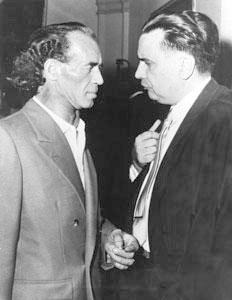
Gröning’s unfavorable starting position
At the appeal hearing in January 1958, it was to Bruno Gröning's disadvantage that it was the state prosecutor who had appealed, and not he. Not only did this carelessness on the part of his then solicitor damage him; the delay in handing over the dossier material to Gröning’s new legal aide also hindered the preparation for the hearing.
The prosecution witnesses’ much more confident and unified appearance served as a further disadvantage . They appeared to have reached an agreement on the subject of “prohibition of the doctor.”
Prison, a fine, and probation, “a disgrace” without clarification of the healing question
This time the sentence was as follows: eight months in prison for causing death by negligence, and a 5000 DM fine for violation of the Non-Medical Practitioners act. The sentence was suspended.
Anny Freiin Ebner von Eschenbach, who attended not only the second, but also the first court trial, as a spectator in the court room, described the judgment as a disgrace for Germany.
Bruno Gröning declared that he was punished because he did Good. He complained that during the entire time of the trials, not a single person, not even his solicitor, had taken the slightest interest in how a healing came about. Had this question been pursued, it would have become evident that his work had absolutely no connection to medical treatment. The case would have had to be withdrawn. But the clarification of this issue in court had interested nobody. They had preconceived opinions about Gröning and were not prepared to budge.
Petition for appeal shortly before his death
However, this was not the end of the case. This time Bruno Gröning appealed. The date for the hearing was set for January 22, 1959, to take place before the Higher Regional Court in Munich. But this did not occur, for Bruno Gröning died in the same month.
"His Word Banishes Illness"
The healings continued, despite the healing ban and court trial
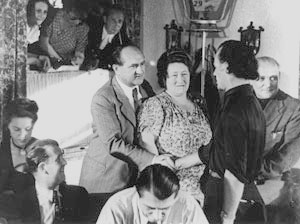
Physical recovery and inner transformation
The work of Bruno Gröning continued during these disputes and battles. In 1957, medical specialist journalist Dr. Horst Mann reported the following, among other things, in a series of articles in Das Neue Blatt (a magazine) under the title “His Word Banished Illness”:
“The next morning I drove from Hamelin to Springe, the little town on the river Deister. A Gröning community had also established itself here. The healings of a number of people had been the starting point for this. And here I experienced it yet again, as I had done so in various parts of Schleswig-Holstein, in Augsburg, Hamelin, Vienna, Plochingen and in other towns. People stood up and told me of their illnesses. They named the doctors who had been treating them. They told of their return to health, that they had Gröning to thank. And in every case, they were willing to raise their hands and swear to this under oath.
‘Already as a baby I had dislocated hip joints on both sides,” explained the 50-year-old Julie Prohnert from Hannover. “Later I could only walk using crutches. The doctor could only ease the suffering. When I was listening to a lecture by Mr. Gröning, I experienced a strong reaction. My back, which had been totally bent, straightened up again. I could walk again. I have had no relapse…’
‘I had rheumatism in my joints and was continually tormented by eruptions and abscesses. Mr. Gröning freed me,’ said Wilhelm Gabbert of Hamelin.
‘I could only tolerate my gall bladder problem by taking morphine,’ reported Kurt Severit of Evestorf. ‘I give thanks to Bruno Gröning for relieving me of this suffering.’
‘I had severe diabetes,’ stated Robert Thies of Springe. ‘More threatening was a weak heart muscle. Both of these troubles no longer affect me today. I have Bruno Gröning to thank for this.’
There was a string of such examples. The people who told me their stories were of all ages, men, women and children. Many illnesses were listed, from headaches to nerve inflammation, sciatic problems, kidney and gall-bladder complaints, to heart disturbances and paralysis.
But there was something else that affected me deeply. With great openness and in front of all those listening, many people told how they had experienced an inner change through Gröning. Their constant drive for success and purely self-centered attitude had given way to an inner calm and peace and a community-oriented way of thinking.”
The person’s faith is what makes healing success possible for everyone
Dr. Horst Mann explained, “As a result of all these conversations with people who felt they had been healed by Bruno Gröning, one question arose increasingly strongly in me. Was healing possible for all people, or, to put it much more boldly, for all diseases? What are the limits of this energy, which radiated out from Gröning? Were there not dangers here? […]
On my last visit I put this question to him. ‘I cannot and do not want to force anybody,’ he told me. ‘If someone closes themselves and is not prepared to open themselves to the energy which will bring order, then I myself am not in a position to intrude. All I do is challenge these people to burst the fetters of the evil that prevent well being and health.’
I had another question. ‘Every disease has a different degree of danger,’ I said. ‘What if a seriously ill person who has been abandoned by several doctors allows a doctor who is still prepared to fight for his patient, to call you on his behalf? Would you be able to help?’
‘Yes.’ Grönings reply came without hesitation. ‘If the patient has belief, and if the doctor trusts the path he has taken, success will not be absent. Their joint belief will develop unimagined powers in the patient. Most often, the success occurred most quickly at the precise moment when the despairing person was grasping at the last straw.’”
Parting from the Gröning Association
Time to take stock of the damages
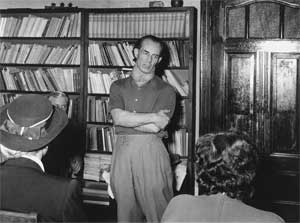
Narrow-minded bureaucracy watches passively as Gröning is fined
In October, 1957, relations between Bruno Gröning and the managers of the Gröning Association ended in confrontation. Through narrow-minded bureaucracy, the Gröning Association had done him considerable damage. The cause of the dispute was the court judgment which required Bruno Gröning to pay a 2000 DM fine within a short space of time. Since he had never taken any money for his work, and as a result, had no money to speak of, the Gröning Association committee had agreed to bear the costs of the court case from the beginning. Whether this included the fine was disputed within the committee. The committee wanted to use a drawn-out bureaucratic process to check whether the Association was obliged to pay the 2000 DM or not. Only after this did it intend to deal with the matter of raising the money. As such, it was predictable that the money would reach Bruno Gröning far too late, if at all. The Association stood by and watched, without doing anything, as Bruno Gröning, unable to pay the fine, would instead have to go to prison. This led to an open conflict and finally to a separation.
False friends
In a 62-page document entitled Review of the Activities of the Association, Bruno Gröning addressed all the points by which the Association had caused him damage. In summary he stated, “When I draw comparisons today between my earlier environment (the profiteers Meckelburg, Enderlin, Schmidt and Hülsmann) and my current environment (the Association's committee members), then I come to the same conclusion. Today the end result is the same as then. Today, through the work of those who are supposed to be my closest and best friends, nothing more has been achieved than at that time. Back then I was betrayed by the dirty deeds of those helpers. Today friends have failed me, in that they have stood quietly by and watched as I went through the court case, through the accusations, in that I received no help, in that I wasn't able to visit my local communities, as no vehicle was made available to me, in that no one took any action against the smear campaign which was waged against me, in that you caused confusion by not being there for me when I needed people. People who with all their worldly knowledge, learning, and experience, could and had to support me, so that it wouldn’t come to this at this one time when I am on this earth.
Not one of these friends engaged themselves on my behalf, to fight for my freedom; no one had the courage to really stand up for me. Nothing was done. Decision after decision was made on the basis of petty bureaucracy. No one really got involved on my behalf; no one committed himself with all his might to freeing me once and for all from all these battles in the courts, against the press, for an assistant for my work, for the car which was unserviceable, against the smear and slander campaigns, etc. etc. and cleared the way for me so I could do that for which I am here to this earth: to deliver to humankind the power of life, and lead people to belief.
That I need peace and quiet for that, and to not constantly be interrupted and prevented by external worldly influences, that I need a real protective wall in order to allow that which is given to me to work undisturbed; no one had thought about that. None of my friends, not one of those who wanted to be my friend. And this is what is really shameful and so disappointing to me:
- The profiteers wanted to gain advantage, and they have been recognized as bad people.
- Friends from the Gröning Association are too half-hearted, too indifferent, and too comfortable; I won't say ill-intentioned.
And the result is the same; I am not free. Many friends from the Gröning Association committee have not kept their word. I have been hampered by everything that has been done."
The failure of the Association
Weisser stepped down, and the Gröning Association, which never managed to be officially registered as an association, was disbanded shortly after. In its place there arose the Association for Advancement of the Spiritual and Natural Principals of Life. It was established in 1958, and its leaders were Erich Pelz from Germany and Alexander Loy from Austria. But this, the last organization founded during Bruno Gröning's lifetime, did not deliver what he had hoped for from it, either. His name did not appear in its constitution even once.
The great trial (1955-1957)
Indictment on charges of negligent homicide and acquittal with absolute healing prohibition
 On March 4, 1955, the State Prosecution again brought charges against Bruno Gröning. Once again, he was accused of contravening the Non-Medical Practitioners Act . In an additional charge, he was accused of negligent homicide.
On March 4, 1955, the State Prosecution again brought charges against Bruno Gröning. Once again, he was accused of contravening the Non-Medical Practitioners Act . In an additional charge, he was accused of negligent homicide.
Gröning denies promising healing and prohibiting medical treatment
After he had been served with the summons, he turned to his friends. “My dear friends! In recent days the entire press and radio has reported in a more or less biased form that the State Prosecution Service II of Munich has prepared a case against me for causing death by negligence. I am supposed to have promised healing to a seventeen-year-old girl at the end of 1949, and of having hindered her from visiting a sanatorium and a doctor. Apparently, I am responsible for the death of this young person. Whoever has read or heard these reports with a clear mind will have recognized their purpose: to produce confusion among my friends and to prevent all those seeking help from concerning themselves closely with the knowledge I have disseminated, and all our efforts. All means are being used to hamper my activities, as well as those of the Gröning Association, and even yourselves. Of course, the fact is that things are different from how they are being portrayed! My friends, I don't need to explain anything here. You know that I make no promises of healing, and that I never advise against medical treatment.”
Unusually late re-opening of the investigation
Gröning continues to his friends, “I was cleared of charges in 1952. Isn't it curious that the ‘Kuhfuss Case,’ which arose at the end of 1949, the beginning of 1950, was not rolled out in the court case of 1951-1952? Although all the documents were already prepared, and lay before the court. Isn't it striking that a new case was launched against me exactly at the time when it was made public on November 22, 1953 in Murnau, that the Gröning Association had been founded! Truth is, since January, 1954, a large number of regional group leaders and friends, and also members of the Association have been interviewed and kept under observation by the police.”
Witnesses for the defense rejected, witnesses for the prosecution welcomed
The preparations for the proceedings took over years. Bruno Gröning’s defense was hampered considerably. Virtually all witnesses who could give testimony to his advantage were rejected; the prosecution witnesses on the other hand, were accepted. Among these were two previous associates of Gröning, Eugen Enderlin and Otto Meckelburg. Meckelburg in particular – he had been jointly accused in the first court case – turned against Gröning in a conspicuously severe fashion. He did everything in his power to harm him. He played a particularly important role in the matter of causing death by negligence. It involved a situation which occurred during his time as Gröning’s „manager“.
The manipulated case of Ruth Kuhfuss
In November 1949, Emil Kuhfuss, an official of the Sparkasse (a bank,) came to a lecture given by Gröning, with his seventeen-year-old daughter Ruth, who was suffering from tuberculosis in both lungs. Gröning recognized immediately that the girl was beyond help and expressed this to a doctor who was present at the time. Meckelburg, however, strongly pressured him and demanded he take up the case. As a result, after the lecture, a face-to-face meeting between Bruno Gröning and Ruth Kuhfuss took place. Gröning told the girl to have courage and advised the father to arrange for a medical specialist to carry out an examination in nine days. He thereby intended for the girl, who didn't want anything more to do with doctors, to be back under medical care. The father promised to concern himself with this.
The correspondence that took place in the subsequent period was handled by Meckelburg and never reached Bruno Gröning. He next heard of Ruth Kuhfuss in May, 1950. The father, in the meantime, had sent pleading letters to Gröning imploring him to visit. Meckelburg never passed these letters on, but of his own volition, and without Gröning's knowledge, agreed to a meeting with Mr. Kuhfuss. Only shortly before the date for the meeting did Meckelburg inform Gröning, and compel him to accompany him to the meeting.
Meckelburg later stated that Bruno Gröning had promised to heal the girl. In fact, it was Meckelburg himself who had assured the father that he would persuade Gröning to heal his daughter. Meckelburg saw in the bank official a source of income that he wanted to tap into, and to do this he needed Gröning. Shortly after the visit, Gröning parted ways with Meckelburg.
A serious allegation made against Gröning was that he had forbidden Ruth Kuhfuss to seek further medical treatment. On the contrary, the fact was, and this was even confirmed by witnesses for the prosecution, that even at the first meeting, he had sent the girl to a doctor. As well, in a radio interview in Autumn, 1949, he appealed to the people “to continue with medical check-ups right until the end.” He continually advised those who came seeking help to trust their doctors.
Ruth Kuhfuss, who had already undergone several unsuccessful and painful forms of therapy, refused to accept any further treatment. She died as a result of the disease on December 30, 1950.
Medical expertise confirms no hope of healing
From the medical point of view, Dr. Otto Freihofer shed light on the matter in his statement on the case of Ruth Kuhfuss as an expert witness. “When soberly observed, even the non-professional would have to come to the conclusion, as indeed it was expressed by the Säckingen Health Authority, that in light of the ‘very serious condition,’ which were, according to the doctors’ findings, ‘life threatening’ or ‘critical,’ a healing was, according to normal human expectations, out of the question, just as every right-thinking and sine ira et studio doctor who, while having the latest medicine at his disposal, was not too conceited to believe that he could dispense with the power of nature, would have to agree with the opinion of the expert testimony of Prof. Lydtin of Munich, which stated that ‘it cannot be said that prior to November 5, 1949, there was much chance of a cure. In my opinion, it is more than astounding that the patient survived up until December 30, 1950, and it could well be that Gröning’s influence had in fact given a certain degree of extension to her life. In concluding my expert testimony, I would like to summarize that the claims that ‘chances of healing were taking place,’ and ‘that the life of the patient Kuhfuss could have been extended had Mr Gröning never been near her,’ could neither be made with any certainty, nor are they justifiable.’”
Unsuccessful court verdict
At the end of July, 1957, the jury at the Munich regional court came to a decision. On the point of negligent homicide, Bruno Gröning was acquitted. In the case of violation of the Non-medical Practitioners Act however, a fine of 2000 DM was imposed.
Although at first glance the decision appeared positive, it was unacceptable to Gröning. It was effectively a final prohibition of his work. Through an error of judgment on the part of his solicitor, who assessed the decision far more positively than Gröning, it was not he, but the state prosecutor who filed for an appeal of the judgment. The second hearing took place in mid-January, 1958, once again in Munich.
The Gröning Association
Hoping to be able to work freely through the Association
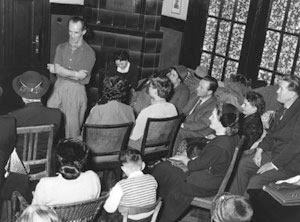 In order to reach as many people as possible, despite the healing ban, Bruno Gröning had established communities at the beginning of the 1950's. There he simply held lectures and directed all his efforts to imparting his knowledge to help seekers.
In order to reach as many people as possible, despite the healing ban, Bruno Gröning had established communities at the beginning of the 1950's. There he simply held lectures and directed all his efforts to imparting his knowledge to help seekers.
Legal protection and renowned management
On November 22, 1953 in Murnau/Seehausen, he established the umbrella organization, the Gröning Association. The Association was intended to be entered in the Register of Associations and to offer Bruno Gröning legal protection for his work. Thus further conflict with the Non-Medical Practitioners Act would be avoided.
The committee of the Gröning Association consisted of, among others, Count Zeppelin, Count Matuschka, Anny Freiin Ebner von Eschenbach, senior engineer Hermann Riedinger and manager Konstantin Weisser, as well as at the beginning, co-founder, Rudolf Bachmann, with whom though, the association soon parted company. Bruno Gröning was President for life.
The secretary’s desire for profit takes precedence over the well-being of the sick
The secretary of the Association was the journalist and lecturer Egon Arthur Schmidt from Heidelberg. Even in Herford, he was a close aide to the “Miracle Doctor” and had founded the association Ring of Friends of Bruno Gröning. It did not function the way Bruno Gröning wished and was disbanded after a short time. Gröning distanced himself from Schmidt at that time, because he had embezzled donations.
In 1952, Schmidt turned again to Gröning and declared that he had recognized the error of his ways. He asked to be allowed to help in the development of the work, and Bruno Gröning took him on as a co-worker once again. This gave Schmidt the chance to show whether the well-being of the sick was really close to his heart, or whether he was simply interested in his own financial advantage.
In 1955, Bruno Gröning permanently parted ways with Schmidt, because the latter had not changed his attitude. He again tried to profit from Gröning's abilities. Schmidt brought several lawsuits against Gröning after the separation. He wanted payment after the fact for his voluntary work.
Who is there for whom – the association for Gröning's work, or Gröning’s work for the association?
Konstantin Weisser and Hermann Riedinger jointly assumed the role of Managing Director. This appeared very promising, because they were very experienced, and their background could be used very much to Bruno Gröning’s advantage. There remained, though, the danger that they would consider themselves superior to the simple worker and act against his will, since he wasn't as educated as they.
Over time, matters did develop in this direction, and it became increasingly difficult for the two men to accept anything that Bruno Gröning said to them. They appeared completely to have forgotten, that the Association not only carried Gröning’s name, but also had been brought into existence for him. For them, the Gröning Association became more and more an end in itself. They lost sight completely of his central goal: to help the suffering. It appeared that they had lost sight of the fact that the healings were made possible through Gröning, and not through the Association.
So the Gröning Association developed more and more into the opposite of what it should have been. For the man whose name it bore, the Association became a prison, which instead of setting him free, restricted him more and more.
The first court proceedings about the healing prohibition (1951- 1952)
Gröning's work a healing activity in the medical sense?
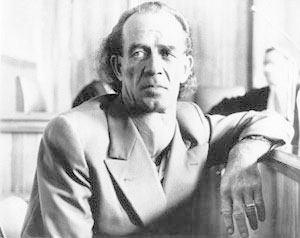
Indictment for unauthorized practice of medicine
In 1951-52, Bruno Gröning appeared for the first time before the court in Munich, charged with practicing healing without a permit. Though the Bavarian Ministry for Internal Affairs had viewed his activity as a free act of love, now it was being evaluated as the practice of healing in the medical sense.
The charge was based on the Non- Medical Practitioners Act of 1939, which had replaced the Freedom of Healers Law, which had been in force up until then, and which was intended to put all healing practice into the hands of National Socialist (Nazi) doctors.
The yes and no of violating the Non-Medical Practitioners Act
Bruno Gröning was acquitted at the first and the second hearings. The chairperson of the Munich court stated in his judgment in March, 1952:
„The court would not consider it fitting to condemn the accused on the basis of one-sided expert testimony, because, whether the activities of Gröning are covered by the Non-Medical Practitioners Act at all is more than doubtful, because they fall into an area that is today researched far too little.“
In the appeal, the not-guilty verdict was upheld, but Gröning’s activity was clearly defined as healing practice within the confines of the Non-Medical Practitioners Act:
„The accused has thereby, without permit and without being a doctor, practiced diagnosis, healing or relief of diseases, suffering or physical defects on people, which is viewed as healing activity under the Non-Medical Practitioners Act.“
Honest error in judgment means healing prohibition
The judgment continued, “A sentencing of the accused cannot follow, however, because in view of the objective nature of the events concerning the exercise of a healing practice, he made an honest error of judgment and thereby did not act deliberately.”
Because the honest error in judgment, which Bruno Gröning supposedly had made, was stated in the judgment, this effectively amounted to a legal healing prohibition, despite the not-guilty verdict. From this point in time on, Bruno Gröning knew that his activities were considered a healing practice as defined by the Non-Medical Practitioners Act, and as such were forbidden. The true nature of his work, which demonstrates that his means of working had nothing to do with healing practices in the medical sense, was not recognized.
Crooks tolerated
Bruno Gröning gives every person the chance to turn around
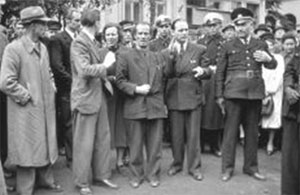
Forced payments: assistants show their true colors
Time and again, people approached Gröning under the premise of supporting him. Many were, however, only interested in profiting from his abilities. He appeared to be an irresistible attraction to such people. When they didn't get what they were after, or he separated himself from them, they tried in many instances to force him into paying them money by means of lengthy legal processes.
For example, in March of 1949, Mrs. Hülsmann, together with her husband, out of gratitude for the healing of their son, took Bruno Gröning in as a guest in their home in Herford. After she had determined that she couldn't earn anything off of Bruno Gröning, she sued him in the labor court. She calculated the time she had initially given voluntarily as working hours and demanded payment in arrears. Bruno Gröning had to pay a monthly sum to her until his death. This was not the only instance. In this or similar ways, many of his previous helpers showed their true colors.
„These people are also necessary; to show who the human being is“
Why did Bruno Gröning let these supposed helpers get so close to him? Why didn’t he simply avoid contact with such profiteers? In a lecture on August, 31, 1950, he addressed the issue: “People have not given up trying to make money off this little man with his knowledge and ability. They believed they had found a goldmine. In part, they have had the chance to make money, but they haven't, thank God, been able to exploit the chance. There also has to be this type of person, in order to identify who the person really is, to show that he tramples the dead underfoot and doesn't ask whether the sick person will be helped or not. There are people who can trample the dead underfoot, and they can calmly look at a sick person lying there. These people have never asked; they have left nothing untried in their attempts to get near to me. I know that here and there the question is raised, ‘Hmm, if the man knows so much, why didn't he know that? Perhaps he knows nothing?’ Whether and to what extent I know something, you will gradually find out. But this has to be. This part was missing in the build-up of this work, in order to make the way free for you all.”
"…then everyone knows who they are"
Grete Häusler (1922-2007), a healed, longstanding helper of Bruno Gröning and founder of the "Bruno Gröning Circle of Friends," describes the following incident in her book, Here is the Truth about Bruno Gröning: “Once, as I was leaving, I wished Herr Gröning all the best and said, ‘Mr Gröning, I wish that you will now be able to have some peace to work and won’t approached by any dishonest workers.’ To my utter astonishment, he said, ‘Completely wrong, this has to be!’ I didn't understand this, but he explained to me why he had to put up with all this and endure it. In so doing, he revealed a great secret to me: ‘I know what a person carries in him. However, if I were to say to people, ‘He is a liar; he is a swindler, a thief,’ no-one would believe me. What must I do? I have to draw these people to me in order to teach them the good, to prompt them to change their ways, and then give them the chance to lie, to cheat and to steal. If they do this, despite what they have learnt, then everyone will see them for what they are. Then I let them get really close to me and I am not a coward, then I fight.’”
New paths and dead ends
Profiteers around Gröning
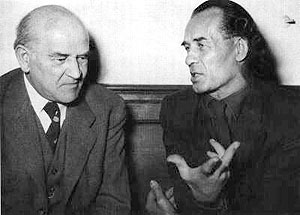
A self-appointed Gröning manager with exclusive rights
Out of gratitude for the healing of his wife, the Wangerooge businessman Otto Meckelburg supported Bruno Gröning and laid out concrete plans for the establishment of healing centers. Bruno Gröning went along with this, and Meckelburg became his “manager.”
At the end of December, 1949, they both went to Wangerooge. Here Gröning spoke at events organized by Meckelburg and worked innumerable healings. He gave the man his complete trust. In a certified statement made on 8 January 1950 in Wangerooge, he laid the future plans for his work entirely in Meckelburg's hands.
“Mr. Gröning consented to Mr. Meckelburg’s plan and committed to making himself fully available to achieving this goal, that is, to give Meckelburg all necessary support, and to do everything in his power in relation to the intended founding of an association, and for the association itself in its ensuing activities, and to do everything that could be of service to the aforementioned goals. Mr. Gröning assumes this responsibility towards Mr. Meckelburg personally, and also towards the association with the above mentioned goals, which was in the process of being founded. Furthermore, Mr. Gröning committed to not provide this support for any other person or group. He would conduct his activities only in the context of the association and only with Mr. Meckelburg's consent.”
As early as January, Meckelburg founded the Association for the Investigation of Gröning’s Healing Methods . He himself was Managing Director and drew a monthly salary of 1,000 DM. Bruno Gröning received nothing. It became evident that Meckelburg was not keeping his promise. He saw in Gröning a goldmine and demeaningly described him as ‘the best horse in my stable.’ The sick were of no consequence to him. He had bound Gröning to himself with a contract, and the “Miracle Healer” had to do whatever he, Meckelburg, wanted.
It was not until June, 1950, that Gröning managed to free himself from Meckelburg, whereupon Meckelburg swore that he would gain revenge. “I'll reduce Gröning to nothing; I’ll break every bone in his body.”
A health practioner with lecture offers
Immediately after this, Gröning worked for several months with the natural health practitioner Eugen Enderlin in Munich. He had received a healing at the Traberhof and offered Gröning the opportunity to hold lectures at his practice. But Enderlin also turned out to want to gain a business advantage. He wasn't interested in helping, but wanted to make money off of the “Gröning Phenomenon.” Towards the end of the year Gröning parted from him, and a further partnership in 1952-53 failed for the same reasons.
A Careerist Healer
In the period following this, Gröning held lectures in the Weikersheim boarding house in Graefelfing. The journalist Dr. Kurt Trampler took him in and organized the meetings. He’d known Gröning since the autumn of 1949. He had been sent to the ‘Traberhof” to produce a report for a Munich newspaper and had unexpectedly been healed of a leg complaint. In gratitude, he wrote the book The Great Turnaround and took up Gröning's case with the authorities. As with Enderlin, the lectures in Graefelfing were well attended. Unbelievable healings took place. But the partnership with Trampler didn't survive, either. One day Trampler believed he had learnt enough from Gröning, and he broke away and set up independently as a healer.
The Traberhof ‒ masses of people stream to Rosenheim
Almost 30,000 help-seekers gathered daily before Gröning in September, 1949
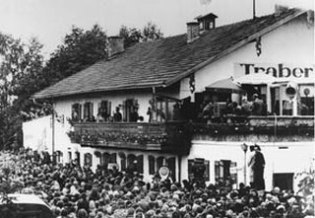 After the investigation in Heidelberg concluded, Bruno Gröning went to South Germany in August, 1949. He wanted to get away from the tumult surrounding his name and withdrew to a private estate near Rosenheim. At first he was able to keep his whereabouts a secret. However, once the first newspapers reported about his arrival in Bavaria, the masses started arriving.
After the investigation in Heidelberg concluded, Bruno Gröning went to South Germany in August, 1949. He wanted to get away from the tumult surrounding his name and withdrew to a private estate near Rosenheim. At first he was able to keep his whereabouts a secret. However, once the first newspapers reported about his arrival in Bavaria, the masses started arriving.
Up to 30,000 people a day streamed to the “Traberhof” in Rosenheim. Press, radio and the weekly news program reported on events. Even a film was made, entitled “Gröning,” documenting the events taking place around him.
Biblical Scenes
In the second week of September, the newspaper Zeitungsblitz reported in a special issue: “Meanwhile, more than 10,000 people had gathered together in the blistering heat for hours, all waiting for the moment when Gröning would appear on the balcony to speak to the masses and radiate his healing energy. The crowd stood densely-packed together, in order to get the full benefit of his ‘healing rays.’ The most seriously ill in their wheelchairs and chairs, or those standing alone at the periphery were already beginning to feel the effects. Half-blind people began to see again, previously disabled people stood up, and paralyzed people began to move their stiffened limbs. Hundreds reported increased pain in the parts of their bodies affected by illness. They reported pulling, prickling sensations and tingling, the feeling of an indescribable ‘lightness of being,’ or of headaches suddenly disappearing.”
Not only at the “Traberhof” were there biblical scenes. Wherever Gröning appeared, he was immediately surrounded by innumerable sick people. Anita Höhne described the situation surrounding Gröning in her book Spiritual Healers Today. Pilgrimages started when Gröning merely announced his impending arrival. Scenes, such as the one journalist Rudolf Spitz observed at a visit of Gröning to Munich in September, 1949, were typical:
“At 7 p.m., thousands were standing in Sonnenstrasse (Sun Street.) At 10:30 p.m., they were still there. During five years of war I had experienced a great deal, but nothing as shattering as in those four hours in which I sat across from Bruno Gröning and experienced a shocking parade of misery and suffering. Epileptics, the blind, lame people on crutches pressed towards him. Mothers held their crippled children out to him. There were unconscious people. Cries rang out, desperate calls for help, pleas, wishes, sighs.”
Government officials recognize goodwill
Anita Höhne quotes the journalist Rudolf Spitz further: “The sick on stretchers, the lame, a huge mass of humanity were observed by another journalist from Munich, Dr Kurt Trampler, who was also at the ‘Traberhof’ in Rosenheim, where Gröning was living. Trampler came there as a reporter for the weekly newspaper Münchner Allgemeine - he was a cool headed journalist, who only recorded what he personally saw and heard. “We hear a voice from the balcony, but not Gröning’s, and hurry towards the window. Pitzer, the president of the Munich police force, speaks to the assembled crowd. He reports that sciatica, which had plagued him for years, has improved in Gröning’s presence. Pitzer is definitely not the sort of man given to hypersensitive imaginings, but can bear witness to that which he observed happen to himself. Here he was openly acknowledging Gröning, and the CSU Politician Hagen followed with a similar statement.”
The Bavarian authorities were also positively inclined toward Bruno Gröning. The daily newspaper Münchner Merkur reported on September 7, 1949, under the title “Goodwill toward Gröning,” “Minister President Dr. Ehard stated at a press conference on Monday, that the work of an exceptional occurence, such as Bruno Gröning, must not be allowed to be squandered because of legalities. In his opinion, no serious obstacles stood in the way of granting Gröning permission to work in Bavaria.”
The Bavarian Ministry for Internal Affairs, had, by copy deadline, announced that the initial examination of Gröning’s healing activities had led to the conclusion that they could be regarded as a free act of love, and as such did not require a permit under the Non-Medical Practitioners Act.
From defamation to medical documentation of the healings
At the Traberhof there a great deal of hustle and bustle around Gröning. There were many business people who wanted to capitalize on his abilities. They damaged his reputation and standing, which resulted in the authorities distancing themselves. When the circumstances became intolerable, Gröning retreated to the mountains of Bavaria. He wanted to look into some of the offers to build healing centers. His goal was to create facilities where help seekers could be healed in an organized way. Doctors would carry out pre- and post-healing examinations along the lines of the Heidelberg model, and document the healings that occurred.
The “Gröning Phenomenon” and science
Medical scrutiny in Heidelberg promises written certificate
 In this time period in Herford medical specialist contributors of the magazine Revue, began studying Gröning’s healing success. Professor Dr. H.G. Fischer, a psychologist from Marburg, traveled to Herford with a special staff of correspondents. There he held interviews with healed people and had to confirm, much to his own astonishment, that Gröning’s “method” was truly a success. As a result, the Revue, decided to help attain a scientific explanation for the “Gröning Phenomenon.” The “healing method” of the “Miracle Doctor” was to be researched at the University Clinic of Heidelberg.
In this time period in Herford medical specialist contributors of the magazine Revue, began studying Gröning’s healing success. Professor Dr. H.G. Fischer, a psychologist from Marburg, traveled to Herford with a special staff of correspondents. There he held interviews with healed people and had to confirm, much to his own astonishment, that Gröning’s “method” was truly a success. As a result, the Revue, decided to help attain a scientific explanation for the “Gröning Phenomenon.” The “healing method” of the “Miracle Doctor” was to be researched at the University Clinic of Heidelberg.
Bruno Gröning agreed to Fischer's proposals because Fischer promised to give him a positive expert testimonial, should things go well. Gröning hoped that he had found a way to work in freedom.
Healings before the doctor’s eyes - "Bruno Gröning is no charlatan"
The investigations began on July 27. The people on whom he was to prove his skills were selected from the over 80,000 sick people who had written to him for help. In addition, there were several patients from the Ludolf Krehl Clinik in Heidelberg. They were all given thorough examinations, and exact diagnoses were established. They then came to Gröning, who used his ‘method’ on them. Doctors were present the whole time. They were witnesses to the fact that some illnesses spontaneously disappeared. Afterwards, examinations in the clinic confirmed the healings. Even incurable illnesses such as ankylosing spondylitis were healed.
In a report, reproduced in the Revue, Dr. Fischer states emphatically that Bruno Gröning is no charlatan, rather a naturally gifted doctor of the soul. In so doing, he tried to explain the “Gröning Phenomenon” from his point of view, without really doing him justice.
Gröning forbids profiteering
The final certificate granting Gröning permission to heal, was to be issued after all the results were evaluated. Bruno Gröning was assured that the way would be cleared for him once and for all to continue with his work. In the meantime, Dr. Professor Fischer and Professor Weizäcker (who were responsible for the whole exercise) made Bruno Gröning the following proposal: they wanted to build healing centers, in which he would work side by side with doctors. The doctors, however, were to be responsible for managing and selecting patients.
To this Bruno Gröning responded, “The financial matters proposed to me in connection with this proposal were such that they were unacceptable to me. Naturally, there were several discussions about this, including with people who wanted to finance this work. I was not able to agree to the proposal from Dr. Professor F. and turned them down because firstly, I do not have a penny to my name, and so I cannot accept any financial commitment which I am unable to fulfill. And secondly, I have never considered making a business out of the entire undertaking. For me it was an impossible request. Besides, I wanted to do only that which belongs to my calling; to help the help seekers and therefore make myself available to doctors such as psychotherapists, but on no account to make a business out of the whole matter.”
Absence of the certificate and potential conflict with the law
Bruno Gröning’s contrary attitude led the professors to lose interest in him. The certificate they had promised was never issued. Instead of providing him with the freedom to continue his work, new obstacles were placed in his way. As a result of the research being carried out, his “healing method” was referred to using words such as “treatment,” “patient” and so on, and thus was judged to be medical practice. A conflict with the law relating to Non-Medical Practitioners Act was thereby inevitable.
1949 – In the spotlight
Bruno Gröning's work in Herford
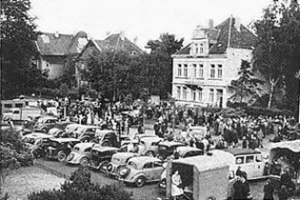
Thousands of sick people and those seeking help besiege Gröning
Nine-year-old Dieter Hülsmann had been bedridden for some time. He was suffering from progressive muscular dystrophy, and none of the doctors or professors who had been consulted had been able to help. After Bruno Gröning began working with the boy, he was suddenly able to walk again. Mr Hülsmann, an engineer, astounded by the sudden healing of his son, asked Bruno Gröning to stay. He wanted to invite other sick people ‒ this “miracle man” should help them as well ‒ said Hülsmann.
Bruno Gröning accepted the offer, and from one day to the next, more and more help-seekers arrived. Increasing numbers of people learned of the miraculous events surrounding Gröning. It wasn't long before everyone was talking about him. The newspapers reported about the "Miracle Doctor," and in the British Zone he became the subject of daily conversation. Thousands of people poured into Wilhelmsplatz, and throngs of people besieged the house.
Manfred Lütgenhorst, from a daily newspaper, the Münchner Merkur wrote on June 24, 1949, "When I arrived in Herford at about 10.30 a.m., there were almost one thousand people standing in front of the two-story house in Wilhelmsplatz. It was an indescribable picture of suffering. Countless numbers of people in wheelchairs, others brought there by their relatives, blind, deaf and dumb, mothers with mentally and physically disabled children, old women and young men, were crowded together and groaning. Almost one hundred cars, trucks and busses were parked around the square, and all had come from far away."
Paralysis, ulcers, blindness: “Mr Gröning looked at me, and now I am totally healthy.”
Manfred Lütgenhorst continues, “‘Do you believe you’ll be healed?’ I asked one of the sick people. She nodded. One of the people said to me, ‘You should have been here yesterday. Bruno Gröning was not here, but in Viersen in the Rhineland, and here, in the square, five crippled people stood up and went home healed. Distance healing - the yard healed them.’ The other sick people confirmed what had been said.
I made my way further through the throng and recorded their amazing stories. These alone are enough to fill a book. As I lit a cigarette, a young man near me said, ‘Please, sell me one!’ He was wearing a uniform jacket and looked like a serviceman who had returned from Russia. I gave him a cigarette. He lit it and said boisterously, ‘See, I can do everything myself.’ He moved his right arm, his fingers, and his right leg. ‘Did Bruno Gröning heal you, too?’ I asked him. ‘Yes, my right side was paralyzed in Russia. Bruno Gröning looked at me and now I am totally healthy. I still can't fully grasp it.’ Happily, he swung his limbs.
I headed for a group of people surrounding a white-haired woman of about 40 years of age. ‘Of course,’ I heard the woman say, ‘I have been healed by Bruno Gröning. I had huge stomach ulcers, was getting thinner and thinner and couldn't sleep any more because of the pain. There were twelve of us with Gröning. He looked at me, and it seemed to me as if the ulcers fell like a stone to the ground. Since then, I don't have any pain. I'm putting on weight, and the X-Rays I had done show indisputably that the ulcers have vanished. I put myself at the disposal of the Medical Review Commission. I can tell you, they were astonished!’
The woman continued, ‘But that's not all. Last week there was a blind man here in the square. He waited several days and nights without a break. Because I’m often here, I noticed him. I felt sorry for him, and I invited him for a meal. ‘No,’ he declined, ‘I mustn't miss the moment when Bruno Gröning comes out.’ I brought him some rolls and said to him that I would make sure that someone would take him to the railway station. ‘I don't need anyone, because I will be able to walk to the station alone.’ And then I saw it with my own eyes. Bruno Gröning came, and the young man cried out, ‘I can see again!’ Truly, the veil was wiped from his eyes. He described the handbag I was carrying. He said, ‘There goes a car, and that’s the license plate number,’ and he found his way to the station alone. Everyone who was standing nearby was weeping for joy.’
Healing prohibition by city officials and the medical community
It wasn't long before the authorities also concerned themselves with the events. A board of inquiry was formed, and Bruno Gröning was banned from healing. A few influential doctors were his declared enemies. They used every means at their disposal to prevent his activity and demanded that his healing ability be scientifically tested. The real reason for the healing prohibition, however, is clear from the following statement by influential medical people who were involved. “Gröning can prove whatever he wants, but he will not be given permission to heal.” “It offends the professional honor of the doctors to associate with Gröning.” At the end of June, he had to leave Herford permanently. All efforts to obtain permission to carry out healing had failed.
Career and decisive stations in his life
Preparation for his later activities
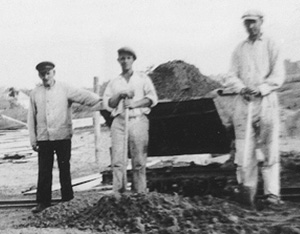
Compulsory and discontinued apprenticeships
After going to school until the fifth grade, Bruno Gröning started a business apprenticeship. He had to give this up after two and a half years, due to pressure from his father, a bricklayer foreman, who wanted his son to learn a trade. He apprenticed to become a carpenter, but this apprenticeship was also never completed. The business turmoil of the post-war period prevented this. Three months before the end of his apprenticeship, the firm at which he was apprenticed closed, due to lack of orders. In the ensuing period, he earned a living at various jobs. Regarding this period Egon Arthur Schmidt wrote:
“He was a success at any work he turned his hand to.”
“Various workmates of his told me that a noticeable feature was that whatever he turned his hand to, he was able to do, whether it was repairing clocks or radios, or whether he was working as a locksmith. He was especially suited to technical things. Also, he was never shy about taking on the roughest and physically most strenuous work. As a dockworker, he pulled his weight. He made no secret of the fact that doing all this was connected to the path which led him through the depths, in order to reach the heights. An old chinese proverb says, ‘He who has never been through the swamp, cannot become holy.’ There are plenty of reports from among his early compatriots, one of which reached me recently. In it the writer says plainly and simply and without reservation, that having worked with him for a year, he was the best and most decent comrad he ever had, and holds fond memories of him.”
Marriage and family misfortunes
He married at 21. However, his wife did not understand him. She wanted to confine him to the narrow role of a respectable family man and dismissed the healings as "vagaries." Both sons, Harald and Günter, born 1931 and 1939, respectively, died at the age of nine. Although countless people had already experienced healing through Bruno Gröning, Gertrud Gröning did not believe in her husband’s healing power. She entrusted the children not to him, but rather to the doctors. Traditional medicine was, however, unable to help them. Both boys died in the hospital, Harald in 1940 in Gdansk, and Günter in 1949 in Dillenburg. For Bruno Gröning, these were heavy blows of fate. Years later, when he spoke about his sons, tears still flowed.
The time between the two World Wars was thus preparation for his later work. He had to undergo these bitter experiences in order to appreciate and understand the feelings and the deep need of people in all life situations.
Helping instead of shooting – at the Russian front and as prisoner of war
In World War II, Bruno Gröning was called up to the armed forces in 1943. Here he came into conflict with his military superiors. Because of his refusal to shoot at people, he was threatened with a court martial. In the end however, he was sent to the front anyway. He was wounded, became a Russian prisoner of war and returned to West Germany in 1945 as a refugee.
Bruno Gröning’s conduct during the war was dictated by his desire to help. Even at the front, he used every opportunity to help his comrades or the civilian population.
In a Russian village, he was able to arrange for the people, who were dying of starvation, to gain access to the army's food reserves. As a prisoner, he fought for better clothing, better food and better shelter for his fellow prisoners. Innumerable men suffering from starvation edema were helped back to health by Gröning. Amidst the horror of the war, he had killed no one, but helped countless numbers of people.
Marital separation and dedication to humanity
In December of 1945, he was freed and built a new life for himself in Dillenburg in Hessen, where he brought his family. After his second son died and his wife tried to prevent all his charitable activities, he separated from her. He felt compelled to allow the healing power at his disposal to flow to all people. He said, "I don't belong to individuals. I belong to humanity."
Early in 1949, his path led him to the Ruhr District. As a result of the reports of a few healed individuals, increasing numbers of people became aware of Bruno Gröning. He went from house to house, always to where he was needed, where the sick people asked him for help. And so he worked in small circles, until, in March, 1949, he accepted the invitation from an engineer in Herford to visit his son.
Childhood and Youth
Beaten, ridiculed, misunderstood, accepted – a child different from the others
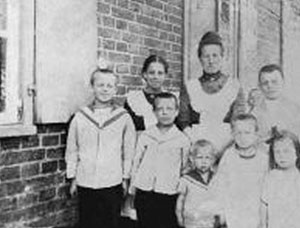
Escape into nature from his hard-hearted surroundings: "Here I experienced God"
Bruno Gröning was born on 30 May 1906, in Gdansk-Oliwa, the fourth of seven children of August and Margarethe Gröning. His parents soon became aware of their son's extraordinary abilities. For example, animals normally considered shy, such as rabbits and deer, spontaneously came to him without fear, to be petted.
As Bruno Gröning grew up, his environment seemed more and more alien to him. Gröning explained that sometimes he was beaten black and blue at home. The beatings, as he said, did not hurt his body, but he felt misunderstood.
Repelled by the hard-heartedness of his surroundings, the young Bruno took refuge in nature. He felt more drawn to animals, trees and bushes, than to some people. He often disappeared into the nearby forest for hours.
"Here I experienced God, in every bush, in every tree, in every animal, yes even in the stones. I could stand and take it all in for hours – time seemed to have no meaning – and it seemed to me as if my inner being expanded into infinity."
He never participated in the wild brawls of his peers. Therefore, he was often ridiculed for being different and was beaten and punished.
Welcome healings of people and animals
With time, an aspect of Bruno Gröning which would later bring him into the limelight became known. In his presence, people and animals would become well. Especially during the first World War, he often visited the military hospitals, where people were happy to see him. The wounded felt good in his presence, and many became healthy. Also, sick people would send for his mother, requesting that she visit them with little Bruno. In the family and among acquaintances, the boy's healing ability was willingly accepted.
Striving for independence
Bruno Gröning wrote in his biography: “Even as a small child, sick people were freed of their symptoms in my presence, and when they were worked up or quarreling, children and grown-ups alike would become calm and peaceful as a result of a few words from me. Also, as a child, I noticed that animals, which normally are considered shy or even dangerous, were good-willed and tame around me. My relationship to my family home, in contrast, was strange and tense. I strove very early for complete independence, in order to free myself from this environment of ‘misunderstanding’ within my family.”
Bruno Gröning (1906-1959)
An extraordinary, yet controversial person
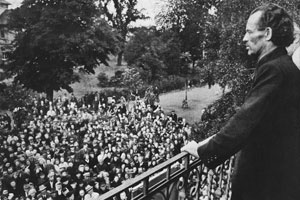 In 1949, the name Bruno Gröning became a household word in Germany overnight. Reports about him appeared in the press, in newsreels and on the radio. Events surrounding the “Miracle Doctor” as he soon came to be called, kept the whole country in suspense. A film was made about him, scientific investigation committees were set up and government authorities at the highest level gave the Bruno Gröning matter their attention. The Minister for Social Affairs in North-Rhine-Westphalia had him prosecuted for violating the Non-Medical Practitioners Act, while the Minister President of Bavaria declared that one could not let such an “exceptional occurrence” as Gröning be squandered because of a few legalities on paper. The Bavarian Interior Ministry described his work as “a labor of love, free of charge”.
In 1949, the name Bruno Gröning became a household word in Germany overnight. Reports about him appeared in the press, in newsreels and on the radio. Events surrounding the “Miracle Doctor” as he soon came to be called, kept the whole country in suspense. A film was made about him, scientific investigation committees were set up and government authorities at the highest level gave the Bruno Gröning matter their attention. The Minister for Social Affairs in North-Rhine-Westphalia had him prosecuted for violating the Non-Medical Practitioners Act, while the Minister President of Bavaria declared that one could not let such an “exceptional occurrence” as Gröning be squandered because of a few legalities on paper. The Bavarian Interior Ministry described his work as “a labor of love, free of charge”.
The case was intensely and controversially debated at all levels of society. Emotions ran high. Clergymen, physicians, journalists, politicians and psychologists were all talking about Gröning. Some considered his miraculous healings a gift of grace from a Higher Power; others believed he was a charlatan. But the healings were fact, confirmed by medical examinations.
Worldwide interest in an unassuming worker
Bruno Gröning, born in 1906 in Gdansk, was an unassuming worker who relocated to Western Germany as a refugee after World War II. Before the war, he had worked in various capacities: as a carpenter, a factory and dock laborer. Then, suddenly, he was the center of public attention. The news of his miraculous healings spread all around the world. Sick people, petitions and proposals came from every country. Tens of thousands of people made the pilgrimage to the places where he was active. A revolution in medicine was on the horizon.
In the strangle-hold of prohibitions, court cases and profiteering assistants
But counter-forces were at work. They did their utmost to foil Gröning’s activities. He was dogged by court cases and healing prohibitions. All efforts to incorporate his work into the existing social structure failed. On the one hand, there was the resistance of those in authority at various levels of the social order, and on the other, the his assistants’ greed for financial profit. When he died in Paris in 1959, the last court case was well under way. The proceedings were halted and a final verdict was never pronounced. But many questions remained unanswered.





